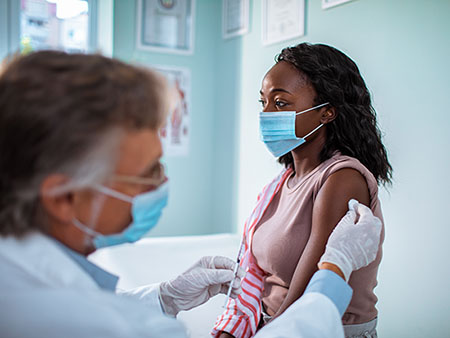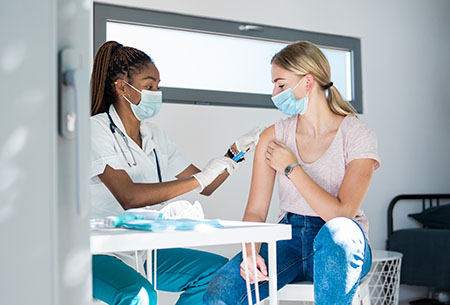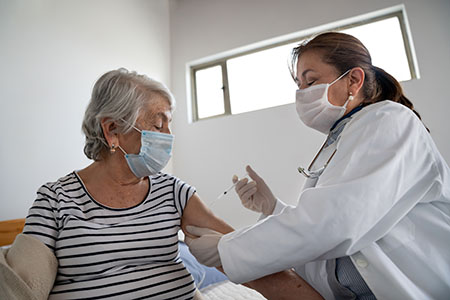Editor's Note: The information published in this story is accurate at the time of publication. Always refer to uab.edu/uabunited for UAB's current guidelines and recommendations relating to COVID-19.
 As the COVID-19 pandemic continues, new words enter our vocabulary daily — words such as antibody, mRNA and placebo. All can be found in the dictionary or on websites for the Centers for Disease Control, the National Institutes of Health, and the United States Food and Drug Administration. But what do they mean as the COVID-19 vaccine begins to roll out at UAB and across the country?
As the COVID-19 pandemic continues, new words enter our vocabulary daily — words such as antibody, mRNA and placebo. All can be found in the dictionary or on websites for the Centers for Disease Control, the National Institutes of Health, and the United States Food and Drug Administration. But what do they mean as the COVID-19 vaccine begins to roll out at UAB and across the country?
Learn the clinical terminology alongside what it means in the context of the beginning stages of vaccine distribution, and visit the UAB United website for a complete list of FAQs.
Adverse events
How the CDC defines adverse events: Any health problem that happens after a shot or other vaccine. An adverse event might be truly caused by a vaccine, or it might be pure coincidence.
What it means for the COVID-19 vaccine: After a vaccine is authorized or approved for use, many vaccine safety monitoring systems watch for adverse events. This continued monitoring can pick up on adverse events that may not have been seen in clinical trials. If an unexpected adverse event is seen, experts quickly study it further to assess whether it is a true safety concern. Experts then decide whether changes are needed in U.S. vaccine recommendations.
The FDA’s June 2020 guidance document includes important recommendations for ongoing safety evaluation after any COVID-19 vaccine is made available in the United States. The CDC is working to expand safety surveillance through new systems such as V-SAFE and additional information sources, as well as by scaling up existing safety monitoring systems.
Antibody
How the CDC defines an antibody: A protein found in the blood that is produced in response to foreign substances (e.g., bacteria or viruses) invading the body. Antibodies protect the body from disease by binding to these organisms and destroying them.
What it means for the COVID-19 vaccine: COVID-19 vaccination will help protect you by creating an antibody response without having to experience sickness. At this time, UAB does not anticipate implementation of a CoV-2 IgG antibody testing program after the first or second dose of vaccine.
Antigen
How the CDC defines an antigen: Foreign substances (e.g., bacteria or viruses) in the body that are capable of causing disease. The presence of antigens in the body triggers an immune response, usually the production of antibodies.
What it means for the COVID-19 vaccine: Antigens trigger immune responses such as antibody production. COVID-19 vaccination will help protect you by creating an antibody response without having to experience sickness.
Clinical trial
How the NIH defines a clinical trial: A research study in which one or more human subjects are prospectively assigned to one or more interventions (which may include placebo or other control) to evaluate the effects of those interventions on health-related biomedical or behavioral outcomes.
What it means for the COVID-19 vaccine: Currently, four large-scale, Phase 3 clinical trials are in progress in the United States, and a fifth is expected to start soon.
Convalescent plasma
How Merriam-Webster defines convalescent plasma: Blood plasma that is obtained from an individual who has recovered from an infectious disease and contains antibodies against the infectious agent of the disease and may be administered by intravenous transfusion to prevent or treat infection in other individuals.
What it means for the COVID-19 vaccine: Currently there is no data on the safety or efficacy of COVID-19 vaccination in persons who received convalescent plasma as part of COVID-19 treatment. The CDC’s Advisory Committee on Immunization Practices recommends that vaccination should be deferred for at least 90 days to avoid interference of the treatment with vaccine-induced immune responses.
 Emergency use authorization
Emergency use authorization
How the U.S. Food and Drug Administration defines emergency use authorization: A mechanism to facilitate the availability and use of medical countermeasures, including vaccines, during public health emergencies.
What it means for the COVID-19 vaccine: The FDA authorized the vaccine under EUA based on an average two months of safety data after vaccination. According to the FDA, Pfizer must collect six months of safety data to apply for full approval. The EUA process has been deliberative, and the authorization was not rushed to meet any artificial deadlines. Plus, because the new coronavirus has surged so severely in recent weeks, we have seen a growing number of COVID-19 cases among placebo recipients, even as those who received the vaccine enjoyed robust protection. In that sense, the worsening of the pandemic has actually increased confidence that the vaccines are effective.
Herd immunity
How the CDC defines herd immunity: A situation in which a sufficient proportion of a population is immune to an infectious disease (through vaccination and/or prior illness) to make its spread from person to person unlikely. Even individuals not vaccinated (such as newborns and those with chronic illnesses) are offered some protection because the disease has little opportunity to spread within the community. Herd immunity to viruses that cause respiratory tract infection is usually acquired by high levels of vaccination in a population.
What that means for the COVID-19 vaccine: Experts have estimated that many people (60-80 percent) would need to be vaccinated to achieve herd immunity to COVID-19. When herd immunity is reached, everyone within the community is protected, even if some people lack protection themselves. Vaccination rates to achieve herd immunity vary by disease.
Immune system
How the CDC defines immune system: The complex system in the body responsible for fighting disease. Its primary function is to identify foreign substances in the body (bacteria, viruses, fungi or parasites) and develop a defense against them. This defense is known as the immune response. It involves production of protein molecules called antibodies to eliminate foreign organisms that invade the body.
What it means for the COVID-19 vaccine: The Pfizer and Moderna vaccines contain synthetic mRNA, which is used to make the COVID-19 spike protein. Because mRNA is highly unstable, these vaccines are made with a lipid nanoparticle that protects it from being destroyed prior to injection. The spike protein is the part of the virus that attaches to human cells. The spike protein alone cannot cause COVID-19. Once the spike protein is created, it causes the immune system to make antibodies against the virus.
The Pfizer and Moderna vaccines require two shots separated by 21-28 days; the second dose of the COVID-19 vaccine functions as a booster, triggering the immune system to produce long-lasting memory cells that stick around to protect against the virus in the future.
Messenger RNA (mRNA)
How Merriam-Webster defines messenger RNA: An RNA produced by transcription that carries the code for a particular protein from the nuclear DNA to a ribosome in the cytoplasm and acts as a template for the formation of that protein.
What it means for the COVID-19 vaccine: The Pfizer and Moderna vaccines contain synthetic mRNA, which is used to make the COVID-19 spike protein of the virus. mRNA vaccines are non-infectious and do not enter the human cell nucleus, so the mRNA cannot be inserted into human DNA. Additionally, once the mRNA is injected into the arm, it is broken down rapidly, and this theoretically reduces the chances for long-term side effects. mRNA vaccines do not have the ability to cause cancer.
Monoclonal antibody
How Merriam-Webster defines monoclonal antibody: An antibody that is derived from the clone of a single B cell and that is produced in large quantities of identical cells possessing affinity for the same epitope on a specific antigen (as a cancer cell).
What it means for the COVID-19 vaccine: Currently there is no data on the safety or efficacy of COVID-19 vaccination in persons who received monoclonal antibodies as part of COVID-19 treatment. The ACIP recommends that vaccination should be deferred for at least 90 days to avoid interference of the treatment with vaccine-induced immune responses.
Placebo
How the CDC defines placebo: A substance or treatment that has no effect on human beings.
What it means for the COVID-19 vaccine: Because the new coronavirus has surged so severely in recent weeks, we have seen a growing number of COVID-19 cases among placebo recipients even as those who received the vaccine enjoyed robust protection. In that sense, the worsening of the pandemic has actually increased confidence that the vaccines are effective.
PCR test
How the FDA defines PCR tests: A real-time reverse transcription polymerase chain reaction (rRT-PCR) test for the qualitative detection of nucleic acid from SARS-CoV-2 in upper and lower respiratory specimens collected from individuals suspected of COVID-19 by their health care provider, as well as specimens collected from any individual, including for testing of individuals without symptoms or other reasons to suspect COVID-19 infection.
What it means for the COVID-19 vaccine: You do not need a COVID-19 test before receiving the COVID-19 vaccine. If you have COVID-19 symptoms after getting the vaccine or at any time, you should contact your health care provider and consider getting tested for COVID-19. You should not sign up to receive the vaccine if you have had COVID-19 within the last 90 days.
 Protein subunit vaccines
Protein subunit vaccines
How the CDC defines protein subunit vaccines: Vaccines that include harmless pieces of a virus instead of the entire germ. Once vaccinated, our immune system recognizes that the proteins do not belong in the body and begins making T-lymphocytes and antibodies. If we are ever infected in the future, memory cells will recognize and fight the virus.
What it means for the COVID-19 vaccine: The first vaccines that will be available will contain either protein subunits, viral vectors or MRNA, which cannot cause infection.
Spike protein
How Merriam-Webster defines spike protein: A glycoprotein that protrudes from the envelope of some viruses (such as a coronavirus) and facilitates entry of the virion into a host cell by binding to a receptor on the surface of a host cell followed by fusion of the viral and host cell membranes.
What it means for the COVID-19 vaccine: The vaccines do not contain the full live SARS-CoV-2 virus and therefore cannot cause COVID-19. The only part of the virus they contain or make is spike protein. Once the spike protein is created, it causes the immune system to make antibodies against the virus. As such, there is NO risk of becoming infected with COVID because of the vaccine.
Viral vector
How the CDC defines viral vector: A weakened version of a live virus. Once the viral vector is inside our cells, the genetic material gives cells instructions to make a protein that is unique to the virus. Using these instructions, our cells make copies of the protein. This prompts our bodies to build T-lymphocytes and B-lymphocytes that will remember how to fight that virus if we are infected in the future.
What it means for the COVID-19 vaccine: The first vaccines that will be available will contain either viral vectors, MRNA or protein subunits, which cannot cause infection.
